2011-09-20: Continuing on from where I left off on 11 September 2011 …
Applying the Recommendations contained in the 2005 & 2008 National Institute of Standards & Technology (NIST – USA) Reports on the 9-11 WTC Buildings 1, 2 & 7 Collapses to the everyday practice of Architecture and Fire Engineering has been a central part of our work for many years. Long discussions on this subject have taken place within CIB (International Council for Building Research) Working Commission 14: ‘Fire Safety’ … and I also chair Commission 14’s Research Working Group IV on ‘Fire-Induced Progressive Collapse’.
My particular interest in Disproportionate Damage and Progressive Collapse reaches back as far as the late 1980’s !
So I was intrigued, amused … and at the same time, highly concerned … to read the following Letter to the Editor of the Irish Times Newspaper, on Saturday 10 September 2011 …
Recalling 9/11
Sir, – One of the most important factors in the tragedy of 9/11, and one that has received scant attention, was the mode of failure of the towers.
They were struck high up on their structures and failed via progressive collapse. Had they been designed this side of the Atlantic, they would not have collapsed. These were flimsy structures. –
Yours, etc,
Jim Ryan, Chartered Structural Engineer,
Waterfall, Cork.
.
JIM … If the WTC Towers (which were not flimsy structures !) had been designed on this side of the Atlantic … they would have collapsed.
Furthermore … If the Towers had only been completed last week in the USA, Ireland, England & Wales, India or China … they would still collapse, if a similar event were to occur next year.
To be crystal clear … What we witnessed, on Tuesday 11 September 2001, was a Collapse Level Event (CLE) which exposed, very harshly and cruelly, a catastrophic failure in all of our common Design and Construction Practices and Procedures used in/by/as …
- Architectural Design | (Ambient) Structural Engineering | Fire Engineering ;
- Building Management Systems ;
- Emergency Responders | Firefighters | Rescue Teams ;
- Technical Control Organizations Having Authority (AHJ’s) or Jurisdiction ;
- Fire Safety Objectives in Building Legislation, Codes and Standards.
To the average ‘person in the street’ … Whether he/she lives in Manhattan or Chicago in the USA, Dublin or Cork in Ireland, Cardiff or London in Britain, Dilli or Mumbai in India, Beijing or Shanghai or Hong Kong in China … it is unacceptable that buildings collapse … entirely unacceptable !!
.
COLLAPSE OF WTC BUILDINGS 1, 2 & 7
JIM … Unless you believe in conspiracy theories, please study the 2005 & 2008 NIST(USA) Reports on the 9-11 WTC Buildings 1, 2 & 7 Collapses. The 2 Final Reports can be downloaded from this Page on Sustainable Design International’s Corporate WebSite … http://www.sustainable-design.ie/fire/structdesfire.htm … along with other key documents and links.
Some indication of the enormous quantity of 9-11 WTC Incident Documentation issued by NIST(USA) can be seen below …
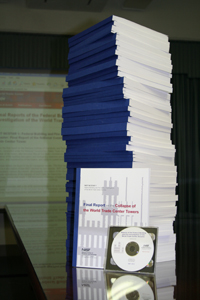
.
PUBLIC SAFETY 10 YEARS AFTER 9-11 ?
If it is entirely unacceptable to the Public that buildings collapse … in how many National Building Codes does the following Critical Public Safety Equation appear today ? The answer is NONE !
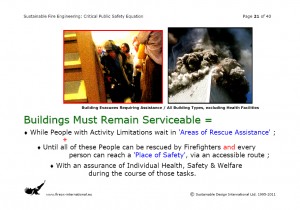
.
Is there some fundamental reason why Levels of Safety for the Public should vary so much from one country to another ? NO, there is not !
Within Europe, and in relation to the New EU Construction Product Regulation 305/2011, which I discussed here a few days ago … the European Commission, in a discussion document dating back to the mid-1980’s, suggested that the only way to effectively realize a Single Market for Construction Products would be to introduce Harmonized EU Building Regulations in all of the EU Member States. Of course the Member States, at the time, went ballistic at the very mention of this idea … and it was quickly withdrawn. I take great pleasure in repeating that important idea today.
Jim … The Critical Public Safety Statement above is fully consistent with … and meets … the ‘Basic Requirements for Construction Works’ in Annex I of EU Regulation 305/2011.
.
However, in relation to any one EU Member State … let’s take Ireland as an example … compare a situation where, in a remote rural location, it might take almost an hour for a sufficient fire service presence to arrive at the scene of a building fire emergency … with a similar situation in the middle of a city, or large town, where the time required will not be greater than 15 minutes … then, although the Level of Safety for the Public can be / should be / must be the same in both situations … I would expect, in the remote rural location having a poor fire service support infrastructure, that the range of Fire Protection Measures to be employed in a typical building would be more extensive, and the performance expected of those Measures would be higher … in order to achieve an Equivalent Level of Safety in both rural and urban locations. Is that not a rational idea ??
Unfortunately, that’s not how the present systems work … National or European ! Levels of Public Safety differ from one country to the next … and from one region, within any one country, to the next … without any good reason … and without meaningful consultation and the full understanding of the Public.
.
BUILDINGS & FIREFIGHTERS ARE NOT YET SAFER
JIM … In spite of all of the spin coming from the other side of the Atlantic … and discounting criminality and fraud in construction practices … Buildings and Firefighters are not yet safer … because the large, difficult, complex flaws and failures in Conventional Fire Engineering have not yet been aggressively confronted … and properly solved.
In a post last year, on 18 October 2010 … I referred to the Cul-de-Sac of Current Fire Engineering … and illustrated a typical architectural detail in a Dublin Building – a common detail also to be found in India, China, USA, England & Wales, etc., etc – which demonstrates a Fundamental Flaw at the very core of conventional thinking and practice.
On Thursday next … 22 September 2011 … at the ASFP Ireland Fire Seminar and Workshop in the RDS, Dublin … I will present this flawed detail … and a solution which is fully compatible with … and answers … the NIST Recommendations !
BUT … would anybody like to show me where any National Building Codes have been revised and updated to solve this Fundamental Flaw ?
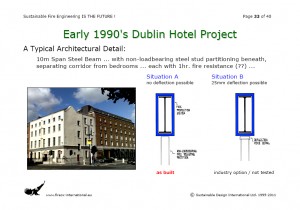
.
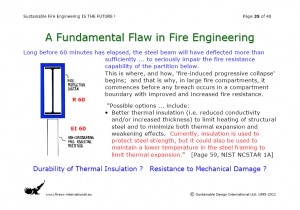
.
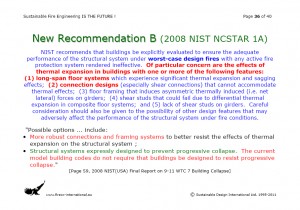
.
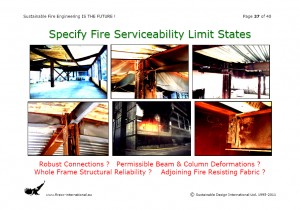
.
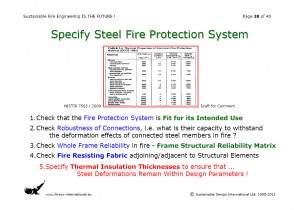
.
A CASE STUDY OF ENGLAND & WALES
10 years after 9-11 … there are two reasons for taking a closer look at England & Wales (Britain) …
- The Building Regulations for England & Wales were used as the model for the Irish Building Regulations, which were first introduced here in the early 1990’s. And, in the absence of Harmonized European Standards … British National Standards tend, with only a few exceptions, to become the default Irish National Standard ;
- British National Standards are being applied in many different parts of the world outside England & Wales … in most cases, without any proper consideration of content … or adaptation to local conditions.
.
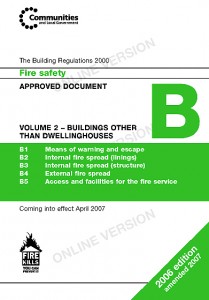
.
The Institution of Fire Engineers (Ireland) Annual Fire Conference, which was held last year, on Wednesday 20th October 2010 … in the Dublin Fire Brigade Training Centre, Marino, Dublin … threw up some interesting ‘notions’ for consideration by a diverse range of participants.
One curious proposition … repeated quite often during the day … was that Approved Document B, in the British System of Building Regulations, was basically still a sound document … and that it should pass an upcoming major review with little difficulty.
I don’t agree … Approved Document B is inadequate and dysfunctional !
With regard to Structural Performance in Fire … instead of referring to Approved Document A – Structure … the reader is referred to Appendices at the back of Approved Document B, which only reinforce the erroneous concept of Single Structural Element Fire Protection …
And along with its many other major problems … see my post, dated 2009-06-14 … British Standard BS 9999 takes no account of any of the 2005 & 2008 NIST Recommendations, Fire-Induced Progressive Collapse or Disproportionate Damage … and, in fact, directly conflicts with aspects of the Building Regulations for England & Wales …
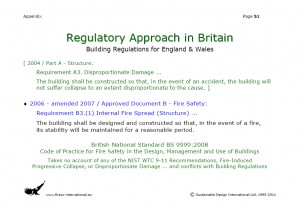
.
In order to take a close look at Approved Document B … I used the vehicle of a Notional Hotel Project in Cardiff, Wales … similar to the Early 1990’s Dublin Hotel Project shown above …
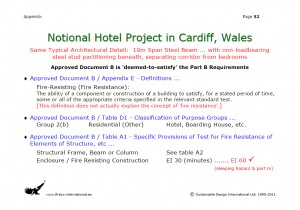
.
With regard to properly showing Fitness for Intended Use of Fire Protection related Products and Building Systems … instead of referring to Regulation 7 … the reader is again referred to Appendices at the back of Approved Document B … which explains why we have such serious problems, i.e. lack of Durability and very low Resistance to Mechanical Damage, with the Thermal Insulation Products used for the Fire Protection of Structural Steelwork …
I also had to quote from Part D of the Irish Building Regulations to fill a gap in the British Regulation 7 …
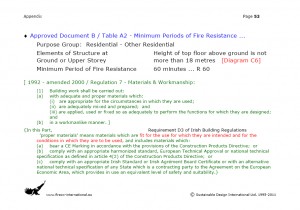
.
.
END
